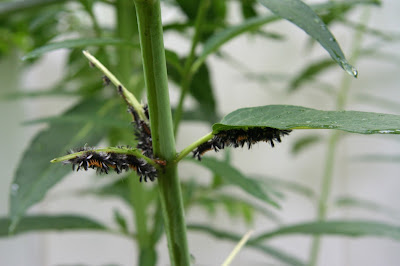I planted Cinderella Milkweed (Asclepias incarnata 'Cinderella') in the back of my kitchen garden last year. Milkweed is the one and only host plant for Monarchs – the only plant they will lay their eggs on and the only plant the caterpillars will eat. There are a few different native milkweeds, Cinderella being one of them.
I find the flowers of Cinderella Milkweed to be truly beautiful. They start out in mid to late June as these tight, pink buds, then when they open the outer petals are pink, but the inner ones are white. The flowers grow in clusters. My plant is about four feet tall this year.
Not only is this plant popular with Monarchs, bees and wasps love it, too. When it flowered, it was constantly covered with them. Mostly they were the smaller bees.
Just look at the hum of activity...
I need to get my bee book out to try to identify these guys.
One day in early July, I noticed these crazy-looking caterpillars on the underside of the leaves.
By the next day they were devouring the leaves.
I had to find out what these caterpillars were, with their long, furry tufts. Turns out they are Milkweed Tussuck Moth Caterpillars. You might be tempted to pet one since they look so fuzzy and soft, but from what I have read, touching one could cause skin irritation.
These fascinating fellows are veracious eaters. I was tempted to try to wash them off with the hose so they didn’t destroy my milkweed, but I couldn’t bring myself to do that. Milkweed are host plants for them, as well, and they eat the leaves much for the same reason the Monarchs do – it makes them toxic to predators. In the case of the moths, which are night owls, it helps to keep the bats away. With Monarchs, it helps to keep the birds away. The good news is, the moth caterpillars tend to eat the leaves from the older shoots and Monarchs go for the younger shoots. The younger moth caterpillars appear grayish and the older ones are the orange, black, and white hairy ones.
I would go out and check on my caterpillar friends every day. Then one day they vanished. Poof! Right into thin air. Never saw them again. Did they wonder off to some other plant to make cocoons and then turn into moths? That is one thing I am not sure about. Need to do some more research on that.
After the Milkweed Tussock Moth caterpillars were gone, I thought my milkweed was safe. In late July / early August, it started to form pods and then the hairy seeds emerged. I find the pods and seeds to be pretty gosh-darn cool.
That’s when I noticed the Small Milkweed Bug.
I only saw the one, but I am sure there were more. These bugs feed on the seeds of the milkweed.
What could possibly happen next to my Monarch host plant? Aphids. Yes, aphids. The nastiest bugs you could ever have and they love milkweed. I didn’t know what they were at first. I noticed these brightly-colored, yellow-orangish eggs all up and down several of the stems.
I tried brushing them off with a small paintbrush, but there still are so many. I am hoping they don’t kill my Cinderella Milkweed because I love it so much and want the Monarchs to be able to use it. I do have other milkweeds and, knock on wood, those don’t have aphids. However, this is my only Cinderella variety and I’d like to keep it please!
What will happen next? Will Cinderella find her prince charming who will save her from these nasty bugs? Or will she meet a dreadful end? Tune in next week (or next year) to “As The Milkweed Turns.”












No comments:
Post a Comment